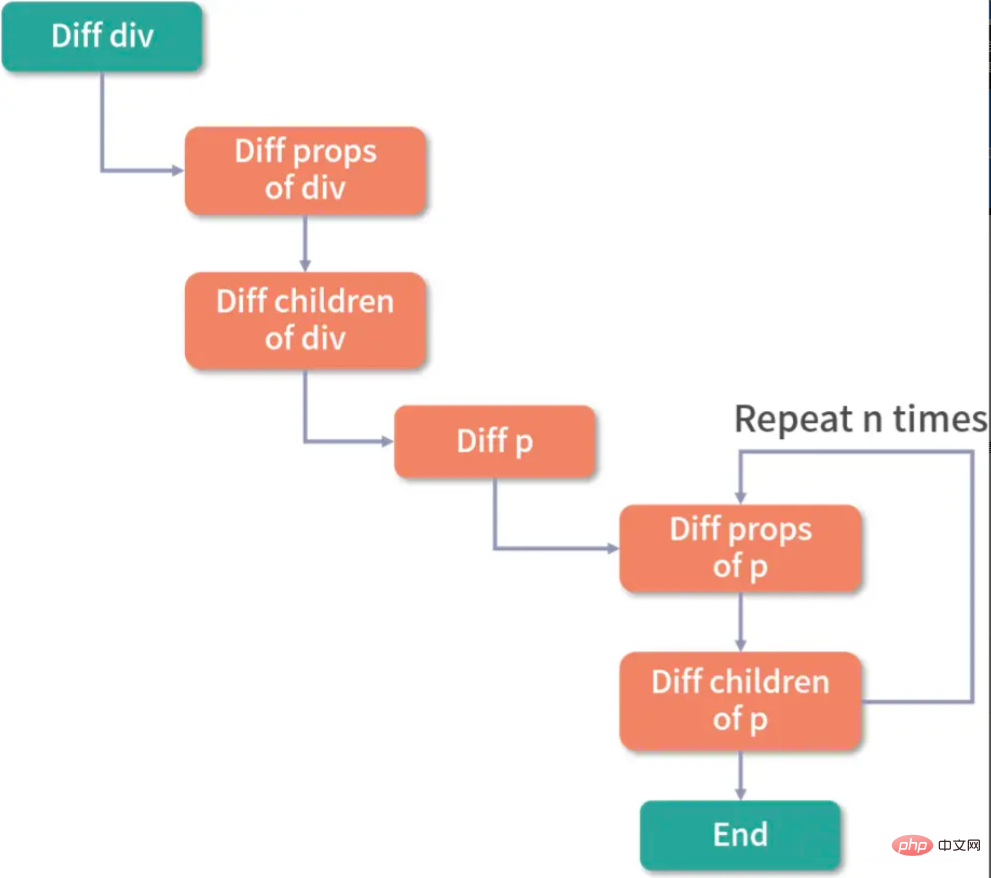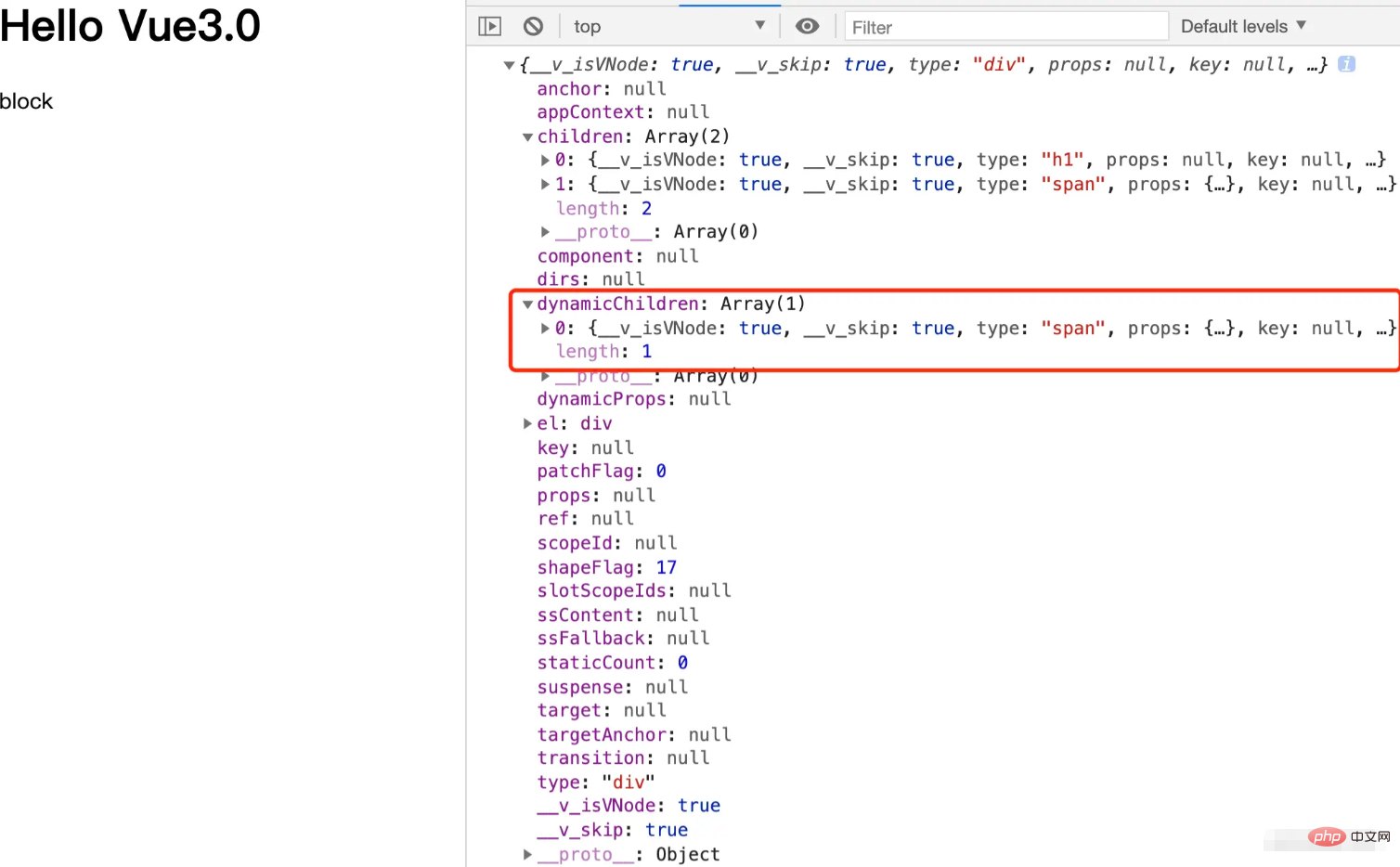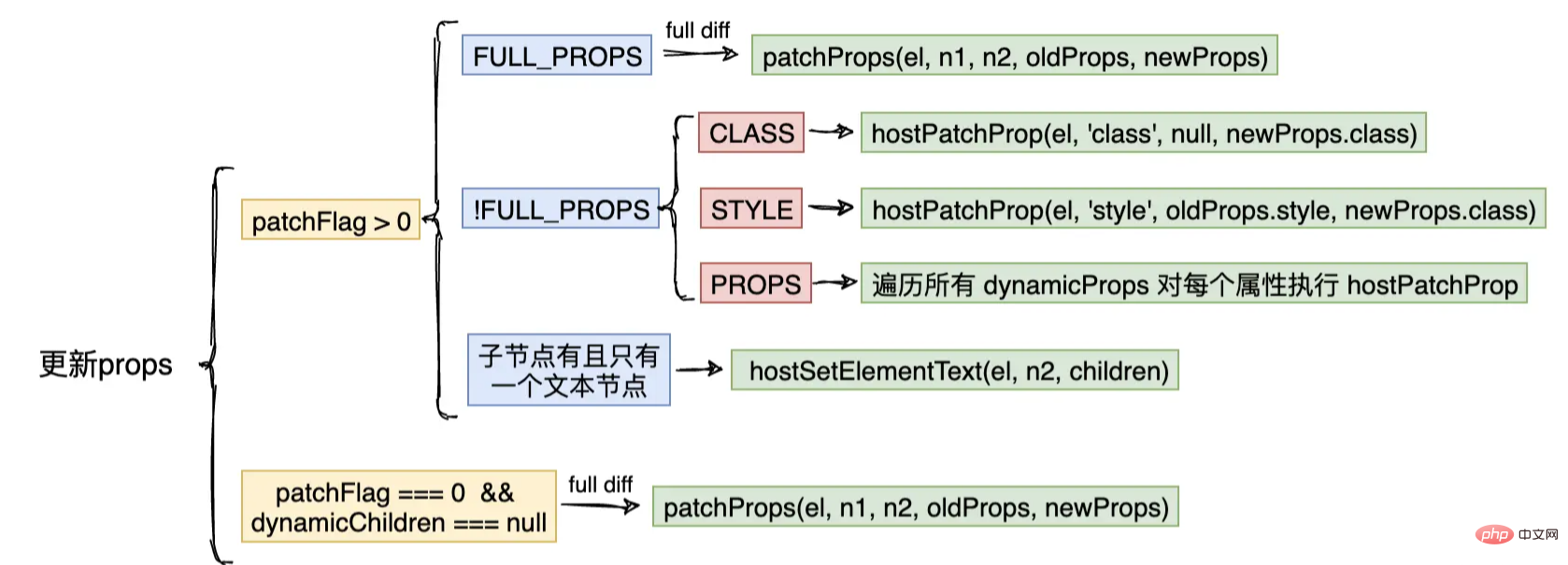vue3编译优化有:1、引入了 patchFlag,用来标记动态内容;在编译过程中会根据不同的属性类型打上不同的标识,从而实现了快速diff算法。2、Block Tree。3、静态提升,是将静态的节点或者属性提升出去。4、预解析字符串化,当连续静态节点超过10个时,会将静态节点序列化为字符串。5、函数缓存;开启cacheHandlers选项后,函数会被缓存起来,后续可直接使用。

本教程操作环境:windows7系统、vue3版,DELL G3电脑。
本文主要来分析 Vue3.0 编译阶段做的优化,在 patch 阶段是如何利用这些优化策略来减少比对次数。 由于组件更新时依然需要遍历该组件的整个 vnode 树,比如下面这个模板:
<template> <div id="container"> <p class="text">static text</p> <p class="text">static text</p> <p class="text">{{ message }}</p> <p class="text">static text</p> <p class="text">static text</p> </div> </template>
整个 diff 过程如图所示:

可以看到,因为这段代码中只有一个动态节点,所以这里有很多 diff 和遍历其实都是不需要的,这就会导致 vnode 的性能跟模版大小正相关,跟动态节点的数量无关,当一些组件的整个模版内只有少量动态节点时,这些遍历都是性能的浪费。对于上述例子,理想状态只需要 diff 这个绑定 message 动态节点的 p 标签即可。
Vue.js 3.0 通过编译阶段对静态模板的分析,编译生成了 Block tree。
Block tree 是一个将模板基于动态节点指令切割的嵌套区块,每个区块内部的节点结构是固定的,而且每个区块只需要以一个 Array 来追踪自身包含的动态节点。借助 Block tree,Vue.js 将 vnode 更新性能由与模版整体大小相关提升为与动态内容的数量相关,这是一个非常大的性能突破。
PatchFlag
由于 diff 算法无法避免新旧虚拟 DOM 中无用的比较操作,Vue.js 3.0 引入了 patchFlag,用来标记动态内容。在编译过程中会根据不同的属性类型打上不同的标识,从而实现了快速 diff 算法。PatchFlags 的所有枚举类型如下所示:
export const enum PatchFlags { TEXT = 1, // 动态文本节点 CLASS = 1 << 1, // 动态class STYLE = 1 << 2, // 动态style PROPS = 1 << 3, // 除了class、style动态属性 FULL_PROPS = 1 << 4, // 有key,需要完整diff HYDRATE_EVENTS = 1 << 5, // 挂载过事件的 STABLE_FRAGMENT = 1 << 6, // 稳定序列,子节点顺序不会发生变化 KEYED_FRAGMENT = 1 << 7, // 子节点有key的fragment UNKEYED_FRAGMENT = 1 << 8, // 子节点没有key的fragment NEED_PATCH = 1 << 9, // 进行非props比较, ref比较 DYNAMIC_SLOTS = 1 << 10, // 动态插槽 DEV_ROOT_FRAGMENT = 1 << 11, HOISTED = -1, // 表示静态节点,内容变化,不比较儿子 BAIL = -2 // 表示diff算法应该结束 }
Block Tree

左侧的 template 经过编译后会生成右侧的 render 函数,里面有 _openBlock、_createElementBlock、_toDisplayString、_createElementVNode(createVnode) 等辅助函数。
let currentBlock = null function _openBlock() { currentBlock = [] // 用一个数组来收集多个动态节点 } function _createElementBlock(type, props, children, patchFlag) { return setupBlock(createVnode(type, props, children, patchFlag)); } export function createVnode(type, props, children = null, patchFlag = 0) { const vnode = { type, props, children, el: null, // 虚拟节点上对应的真实节点,后续diff算法 key: props?.["key"], __v_isVnode: true, shapeFlag, patchFlag }; ... if (currentBlock && vnode.patchFlag > 0) { currentBlock.push(vnode); } return vnode; } function setupBlock(vnode) { vnode.dynamicChildren = currentBlock; currentBlock = null; return vnode; } function _toDisplayString(val) { return isString(val) ? val : val == null ? "" : isObject(val) ? JSON.stringify(val) : String(val); }
此时生成的 vnode 如下:

此时生成的虚拟节点多出一个 dynamicChildren 属性,里面收集了动态节点 span。
节点 diff 优化策略:
我们之前分析过,在 patch 阶段更新节点元素的时候,会执行 patchElement 函数,我们再来回顾一下它的实现:
const patchElement = (n1, n2) => { // 先复用节点、在比较属性、在比较儿子 let el = n2.el = n1.el; let oldProps = n1.props || {}; // 对象 let newProps = n2.props || {}; // 对象 patchProps(oldProps, newProps, el); if (n2.dynamicChildren) { // 只比较动态元素 patchBlockChildren(n1, n2); } else { patchChildren(n1, n2, el); // 全量 diff } }
我们在前面组件更新的章节分析过这个流程,在分析子节点更新的部分,当时并没有考虑到优化的场景,所以只分析了全量比对更新的场景。
而实际上,如果这个 vnode 是一个 Block vnode,那么我们不用去通过 patchChildren 全量比对,只需要通过 patchBlockChildren 去比对并更新 Block 中的动态子节点即可。 由此可以看出性能被大幅度提升,从 tree 级别的比对,变成了线性结构比对。
我们来看一下它的实现:
const patchBlockChildren = (n1, n2) => { for (let i = 0; i < n2.dynamicChildren.length; i++) { patchElement(n1.dynamicChildren[i], n2.dynamicChildren[i]) } }
属性 diff 优化策略:
接下来我们看一下属性比对的优化策略:
const patchElement = (n1, n2) => { // 先复用节点、在比较属性、在比较儿子 let el = n2.el = n1.el; let oldProps = n1.props || {}; // 对象 let newProps = n2.props || {}; // 对象 let { patchFlag, dynamicChildren } = n2 if (patchFlag > 0) { if (patchFlag & PatchFlags.FULL_PROPS) { // 对所 props 都进行比较更新 patchProps(el, n2, oldProps, newProps, ...) } else { // 存在动态 class 属性时 if (patchFlag & PatchFlags.CLASS) { if (oldProps.class !== newProps.class) { hostPatchProp(el, 'class', null, newProps.class, ...) } } // 存在动态 style 属性时 if (patchFlag & PatchFlags.STYLE) { hostPatchProp(el, 'style', oldProps.style, newProps.style, ...) } // 针对除了 style、class 的 props if (patchFlag & PatchFlags.PROPS) { const propsToUpdate = n2.dynamicProps! for (let i = 0; i < propsToUpdate.length; i++) { const key = propsToUpdate[i] const prev = oldProps[key] const next = newProps[key] if (next !== prev) { hostPatchProp(el, key, prev, next, ...) } } } if (patchFlag & PatchFlags.TEXT) { // 存在动态文本 if (n1.children !== n2.children) { hostSetElementText(el, n2.children as string) } } } else if (dynamicChildren == null) { patchProps(el, n2, oldProps, newProps, ...) } } } function hostPatchProp(el, key, prevValue, nextValue) { if (key === 'class') { // 更新 class patchClass(el, nextValue) } else if (key === 'style') { // 更新 style patchStyle(el, prevValue, nextValue) } else if (/^on[^a-z]/.test(key)) { // events addEventListener patchEvent(el, key, nextValue); } else { // 普通属性 el.setAttribute patchAttr(el, key, nextValue); } } function patchClass(el, nextValue) { if (nextValue == null) { el.removeAttribute('class'); // 如果不需要class直接移除 } else { el.className = nextValue } } function patchStyle(el, prevValue, nextValue = {}){ ... } function patchAttr(el, key, nextValue){ ... }
总结: vue3 会充分利用 patchFlag 和 dynamicChildren 做优化。如果确定只是某个局部的变动,比如 style 改变,那么只会调用 hostPatchProp 并传入对应的参数 style 做特定的更新(靶向更新);如果有 dynamicChildren,会执行 patchBlockChildren 做对比更新,不会每次都对 props 和子节点进行全量的对比更新。图解如下:

静态提升
静态提升是将静态的节点或者属性提升出去,假设有以下模板:
<div> <span>hello</span> <span a=1 b=2>{{name}}</span> <a><span>{{age}}</span></a> </div>
编译生成的 render 函数如下:
export function render(_ctx, _cache, $props, $setup, $data, $options) { return (_openBlock(), _createElementBlock("div", null, [ _createElementVNode("span", null, "hello"), _createElementVNode("span", { a: "1", b: "2" }, _toDisplayString(_ctx.name), 1 /* TEXT */), _createElementVNode("a", null, [ _createElementVNode("span", null, _toDisplayString(_ctx.age), 1 /* TEXT */) ]) ])) }
我们把模板编译成 render 函数是这个酱紫的,那么问题就是每次调用 render 函数都要重新创建虚拟节点。
开启静态提升 hoistStatic 选项后
const _hoisted_1 = /*#__PURE__*/_createElementVNode("span", null, "hello", -1 /* HOISTED */) const _hoisted_2 = { a: "1", b: "2" } export function render(_ctx, _cache, $props, $setup, $data, $options) { return (_openBlock(), _createElementBlock("div", null, [ _hoisted_1, _createElementVNode("span", _hoisted_2, _toDisplayString(_ctx.name), 1 /* TEXT */), _createElementVNode("a", null, [ _createElementVNode("span", null, _toDisplayString(_ctx.age), 1 /* TEXT */) ]) ])) }
预解析字符串化
静态提升的节点都是静态的,我们可以将提升出来的节点字符串化。 当连续静态节点超过 10 个时,会将静态节点序列化为字符串。
假如有如下模板:
<div> <span>static</span> <span>static</span> <span>static</span> <span>static</span> <span>static</span> <span>static</span> <span>static</span> <span>static</span> <span>static</span> <span>static</span> </div>
开启静态提升 hoistStatic 选项后
const _hoisted_1 = /*#__PURE__*/_createStaticVNode("<span>static</span><span>static</span><span>static</span><span>static</span><span>static</span><span>static</span><span>static</span><span>static</span><span>static</span><span>static</span>", 10) const _hoisted_11 = [ _hoisted_1] export function render(_ctx, _cache, $props, $setup, $data, $options) { return (_openBlock(), _createElementBlock("div", null, _hoisted_11)) }
函数缓存
假如有如下模板:
<div @click="event => v = event.target.value"></div>
编译后:
const _hoisted_1 = ["onClick"] export function render(_ctx, _cache, $props, $setup, $data, $options) { return (_openBlock(), _createElementBlock("div", { onClick: event => _ctx.v = event.target.value }, null, 8 /* PROPS */, _hoisted_1)) }
每次调用 render 的时候要创建新函数,开启函数缓存 cacheHandlers 选项后,函数会被缓存起来,后续可以直接使用
export function render(_ctx, _cache, $props, $setup, $data, $options) { return (_openBlock(), _createElementBlock("div", { onClick: _cache[0] || (_cache[0] = event => _ctx.v = event.target.value) })) }
总结
以上几点即为 Vuejs 在编译阶段做的优化,基于上面几点,Vuejs 在 patch 过程中极大地提高了性能。
【
















